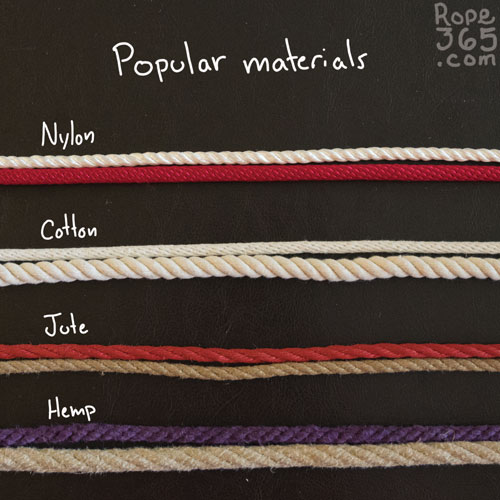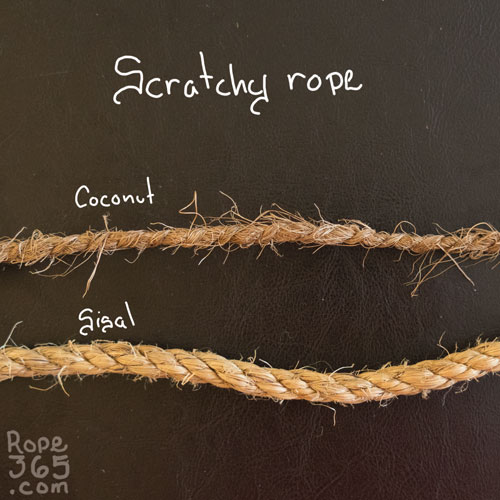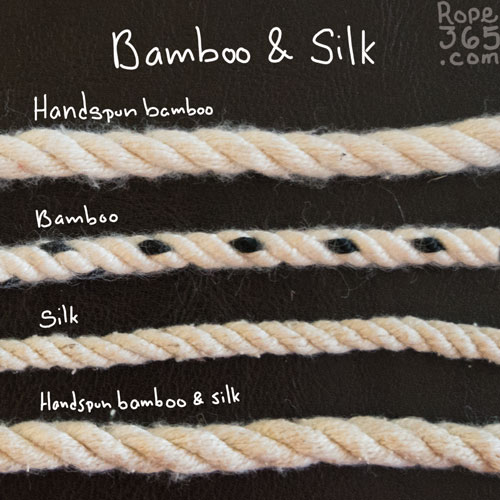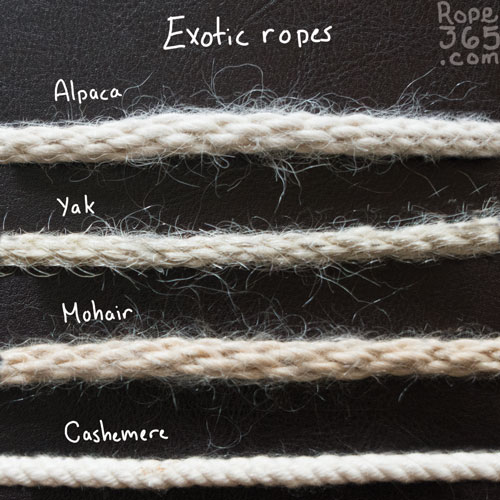Day 44: Material
Many different materials can be used to make rope. Plants like cotton, jute or hemp are quite common rope material, and so are synthetic fibers like nylon, polyester, or MFP. There are also other organic materials like silk or bamboo that are less common but have very interesting properties. Some materials will handle tying knots better than others, some can be unsafe to use for bondage as they contain chemicals that are bad for the skin, others will provide unique sensations. Expanding our understanding of the diversity of rope materials and what makes each of them special will guide us in finding the perfect rope for the occasion.
Characteristics of Rope Materials
To get a better understanding of ropes, we can look at the different characteristics that are related to type of material and how it affects the act of tying.
Burn speed – How fast can you drag the rope on the skin without burning it? The higher the speed the better, as it allows to tie faster without causing injuries and lower the risk of accidentally causing a rope burn. Rope burns are different from rope marks which are caused by rope pressure.
Holding friction – The capacity of rope to hold in place when wrapping on itself. This will influence the types of knots and friction you use. With slippery rope, you might need to add additional knots to hold things in place, or use a full lock instead of just wrapping things around with friction. It is easier and faster to create a stable structure with ropes that have a good grip.
Abrasive vs smooth surface – Some prefer more abrasive ropes and others the opposite. Oiling, waxing and other preparation can help make the rope texture smoother. Smoother rope usually has a higher tendency to create rope burn.
Weight – The lighter the rope, the faster it can be handled. The difference in speed becomes more noticeable as your handling gets better. Some people prefer to have more weight and enjoy how it presses against the body, how it falls on the floor, etc.
Strength – The strength of the rope is usually measured by the amount of loads that can be put on it before it breaks. This criteria has less impact if you aren’t doing suspension or climbing. Even weaker ropes like jute are used in suspension but the line system needs to have more redundancy to mitigate the risks. Industrial ropes such as nylon and cotton are likely to have official tensile strength on the package but most handmade rope won’t as there is too much variation in the making process to make a precise assessment.
Price – Rope that are machine made are generally more cheap. When you start shopping in the more specialized rope, the price ramps up pretty quickly. Depending on your location, some rope may get expensive when adding importation cost.
Reaction in water – Some rope will shrink when wet. This means that the person in the rope will get compressed and knots will become very hard to untie. Drool or wet hair are enough to create small problems if you are not prepared for it. Rope materials like jute that are most vulnerable to water may become permanently deformed when wet. Other rope will not be affected by water, some may sink, some may float.
Maintenance – Some ropes can be tossed in the washing machine and come back sparking clean. Other ropes, especially the ones vulnerable to water, will be damaged in the cleaning process. This means that the rope will take more maintenance effort, and might be impossible to sanitize.
Allergies – Some people are allergic to specific materials, or some of the oils used in the rope preparation. This is more common with rope made out of grass and other organic material. If you already have allergies, it is good practice to get a sample first to find out if a rope is safe for you before spending a lot of money on a kit. Most reputable rope makers will adapt their process to accommodate allergies when they can.
Comparing Popular Materials
Nylon, cotton, jute and hemp are some of the most popular types of rope in bondage. Let’s compare these based on different characteristics. This is an approximate evaluation as ropes are different depending on source and construction.
Nylon/MFP – These two synthetic types of rope share most characteristics. They usually have a shiny slick appearance and are a bit slippery to work with. They can be easily found at the hardware store for a low price but higher quality products can be found from specialized vendors. There is a huge variety of ropes made out of these materials so don’t stop your opinion at the first one you try.
Cotton – A soft rope that can also be easily found at the hardware store. This is a very good starting rope as it is quite average on most characteristics, easy to wash and cheap to buy.
Jute – The traditional Japanese style rope, light and fast to use, holds frictions firmly and looks terrific in photography. It has a more stiff texture and makes some cracking noise that some will love or hate. Jute can be quite abrasive when brand new and will become more smooth with use. As it finds few uses outside of the bondage world, jute is harder to find outside of specialized rope makers, which increases the price. It is a pain to clean as water deforms the fibers and it needs to be stretched to dry or be ruined forever.
Hemp – Studier and heavier than jute, with a similar tooth and “natural” look, hemp is another popular rope material. People will usually love or hate it’s unique grassy smell. Hemp is seldom sold outside of bondage rope maker shops, but can sometimes be found in eco-friendly shops who sell other hemp products.

Exotic Ropes
There are too many types of rope to list them all but some have special characteristics that make them a nice addition to the toy bag.
Scratchy Ropes
Sadists and masochists alike may enjoy very abrasive ropes such as manilla, sisal, coconut, rice or palm front. Beware, the hands of the sadist will also suffer! Manilla and sisal are easily found in the hardware store, but they will often be full of chemicals that don’t make it safe to use on skin. Coconut is sometimes used in the brewing process and can be found for cheap in some brewing stores. In this case, the rope is food grade and safe to use on the skin. Rice rope is also interesting as it was the type of rope used in lots of early Japanese photography and has a particular aesthetic. After some use, these ropes will become smoother and progressively lose their evil edge.
Bamboo and Silk
Bamboo rope is usually very soft and has a little bit of elasticity to it. It is common to see it mixed with silk for a really soft experience. The anti-microbial characteristics of bamboo rope makes it interesting for ties that are in contact with genitals and fluids. A lot of rope sold under “silk” is actually MFP or nylon, check the labels to make sure you are buying what you think you are.
Strong Rope
Some rope is mostly sought out because of their higher tensile strength for use in suspension or climbing. These rope materials also have various qualities that make them interesting outside of suspension.
Hempex – Strong like nylon, with the look of hemp and a somewhat abrasive texture. Hempex floats in water and doesn’t shrink when wet which makes it a very interesting rope for water bondage.
POSH – Made from polyester, POSH mimics the look of natural rope with a high tensile strength, a less abrasive texture than hempex but a bit less grip and flexibility.
Paracord – A thin, lightweight and very strong rope made of nylon that comes in a variety of colours. As you can guess from its name, it is made for parachutes, but is also popular for microbondage and decorative ties. Military shops usually have a selection for a low price.
Reinforced rope – Some rope makers will add a strand of a stronger material in their rope to increase their tensile strength. This process will create a rope that can have a very natural look but will affect rope abrasiveness and burn speed.
Animal Hair
Rope made out of animal hair such as cashmere, mohair, alpaca or yak are less common but have interesting characteristics. The price of these exotic ropes is generally much higher, but each provides a unique texture that is both soft and scratchy.
Elastic Ropes
Climbing rope or bungee cord can allow some fun predicaments or dynamics. It is not recommended to use elastic ropes directly on the skin as they may create a tourniquet effect and can behave unpredictably. They can be interesting to attach to two parts of the body, add dangling objects, or to tie someone to a fixed point with a reward out of range. They also make excellent slapping tools.
Electro conductive rope
Rope can be weaved with other materials, it is interesting to have some electroconductive twine in the rope to combine it with other toys like a violet wand for a different kind of play.
Practice Time!
Make a trip to the hardware store, your local rope practice or the vendor area of a rope conference. Gather as many types of rope as you can, try them out and explore the differences. Many online stores can also send you samples for a small fee.
Pick a tie you enjoy, try to do it with as many different types of rope as you can.
Exploration ideas
- How does it feel on the fingers?
- How does it feel being tied in?
- Compare the same friction with different types of rope
- Does it stretch? How does stretching affect tension when tying
- Do you like the smell?
- What happens when the rope is wet? Does it float?
Inspirations and Resources
- Choosing the Right Rope for YOU by BryanT-Corn’
- Bondage Rope: What Kind Of Rope Is Best For Bondage? By Pete Riggs
- Jute by Amatsunawa
- Grading & Impurities by Amatsunawa
- Tying Shibari with “Slippery Rope” Nylon Etc. by kni
- Synthetic fibers used in rope manufacture by -Steven-
Credit: R/P Ebi McKnotty
Or return to The Rope for more options.





2020-04-08 at 2:28 PM
Real knowledge, well presented without prejudice.
Table is excellent.
2023-02-05 at 10:33 AM
Thank you. I’ve been trying to collect information from people with various preferences, but it’s hard when I love jute so much. I wish I had that table when I got started.
2023-05-19 at 9:14 AM
I also like another material on your website called “kni’s Rope Materials Primer”. I didn’t know about POSH type, want to try. In China it is easy to find cheap hemp ropes on the market, but most of them smell so awful, hard to get rid of that odour. Also it is a bit annoying to have rope fibers everywhere in the room. I found that braided cotton rope is the best choice for me due to its softness and absence of any smell. After several attempts I got one that does not stretch too much.
I also tried twisted synthetic rope, but it was so hard that leaves rope marks after a short time. Braided synthetic, cotton and hemp are much softer.
2023-05-20 at 7:23 PM
Thank you for sharing. Finding the right rope for you often involves trying a lot of things.
2024-09-19 at 10:53 AM
A useful rope to try is flax, often sold as linenhemp. I have a friend who is allergic to both hemp and jute. Flax works for them.